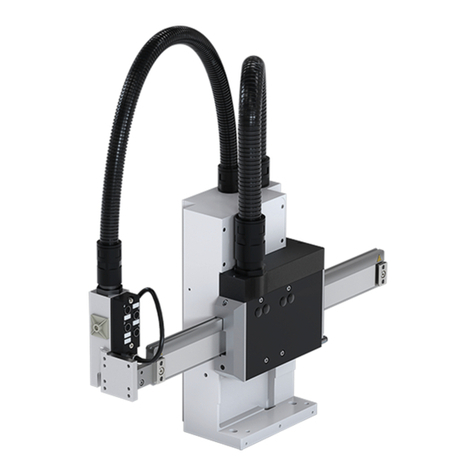
WAS.handling Electro Documentation 6
2.2 Technical Data
2.2.1 Drive control – power section:
Depending on customer requirement, one of the following drive controls is used:
Model: ACOPOS 8V1010.50-2 ACOPOS 8V1022.50-2
Permitted temperature ranges: storage: -25°C...+55°C
operation: 0°C...+40°C
Installation position: vertical
Air humidity: 5 to 95%, without condensation
Mains input voltage: 3 x 110 VAC to 230 VAC ± 10 %
or
1 x 110 VAC to 230 VAC ± 10 %
Mains filter according to EN 61800-
3-A11 second environment (Limits
from CISPR11, Group 2, Class A)
3 x 400 VAC bis 480 VAC ± 10 %
Mains filter according to EN 61800-
3-A11 second environment (Limits
from CISPR11, Group 2, Class A)
Frequency mains supply: 48 – 62 Hz
Installed load: max. 1,35 kVA max. 3 kVA
main fuse: 10 A time delay
(both axes together) 10 A time delay
(both axes together)
Peak current: 7,8 Aeff 14 Aeff
Continuous current: 2,0 Aeff 2,2 Aeff
Starting current: 5 A (at 230 VAC) 4 A (at 400VAC)
Switch on interval: > 30 sec
Power loss: < 80 W < 120 W
EMC: according to EC directive 89/336/EWG
applicable harmonized standards:
EN 61800-3 (noise resistance)
EN 550011, class B (noise emission)
Low voltage directive: according to EC directive 73/23/EWG
applicable harmonized standards:
EN60204.1 / VDE113
Protection according to
IEC 60529:
IP 20
C-UL-US listed: yes
Dimensions: width: 58,5 mm
height: 257 mm
depth: 220 mm
width: 70,5 mm
height: 375 mm
depth: 235,5 mm
Weight: 2,5 kg 4,0 kg
2.2.2 Drive control – 24V-control section:
24 Volt control voltage: 24V DC +/-10%, residual ripple < 10%
Power consumption 24 Volt: max. 2.5A / 1.2A typical
- note: 24V for fan is provided from DC-Bus
- note: Fuse: 6A time delay
Input voltage 24V nominal / 30V max.
Switching threshold LOW <5V
HIGH >15V
Input current approx. 30mA at 24V
Enable Input – X1/9
Switching delay <2ms
number of inputs 2
level LOW <5V
HIGH >15V
input current approx. 4mA at 24V
Digital Inputs – CPU X4:
(4.1; 4.2)
input filter <1ms
number of outputs 1
Digital Outputs – CPU X4:
(4.3) output current max. 0.5A each Output
Profibus (optional) Profibus DP Slave, ≤12Mbit, potential separation
CAN-Bus (optional) 500kBit/s, potential separation




























